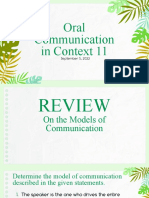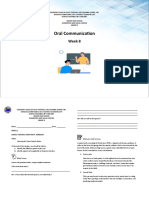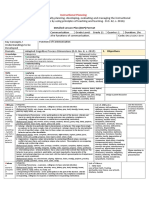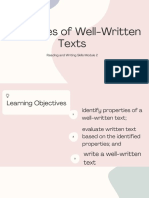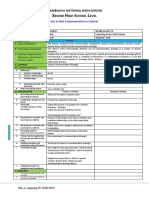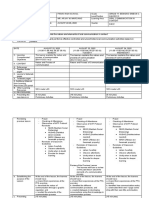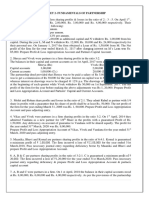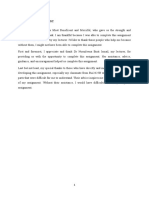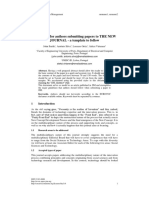Cot DLP Kpup Iniego
Cot DLP Kpup Iniego
Uploaded by
Joan IniegoCopyright:
Available Formats
Cot DLP Kpup Iniego
Cot DLP Kpup Iniego
Uploaded by
Joan IniegoOriginal Description:
Original Title
Copyright
Available Formats
Share this document
Did you find this document useful?
Is this content inappropriate?
Copyright:
Available Formats
Cot DLP Kpup Iniego
Cot DLP Kpup Iniego
Uploaded by
Joan IniegoCopyright:
Available Formats
School: PATIN-AY NATIONAL HIGH SCHOOL Grade Level: 11
Teacher: JOAN D. INIEGO Learning Area: ORAL COMMUNICATION
Date: JANUARY 2023 Quarter: II
Section: EINSTEIN Division: AGUSAN DEL SUR
I. OBJECTIVES
A. Content Standards The learner recognizes that communicative competence requires understanding
of speech context, speech style, speech act and communicative strategy.
B. Performance The learner demonstrates effective use of communicative strategy in a variety of
Standards speech situations.
C. Learning Students will:
Competencies Explains that a shift I speech context, speech style, speech act and
communicative strategy affects the following:
D.
E. Objectives At the end of the lesson, the students are expected to:
Identify and discuss the two forms of language form
Appreciate the importance of both formal and informal language in the daily
activities
Make a role playing of a real-life examples where language form was adapted
effectively
E. E. LC Code EN11/12OC-llab-22
II. CONTENT
A. References Oral Communication
1. Teacher’s Guide pages Self-Learning Modules
2. Learner’s Material English for Academic and Professional Purposes Self Learning Modules
pages
3. Textbook
4. Additional Materials Laptop, pictures, TV, hand-outs, mobile phones
for Learning Resource
(LR) portal
5. Teacher’s strategy Differentiated Instruction, Discovery Method, Student Led Classroom, Teacher
as a Facilitator
B. Other Learning Quizizz applications
Resources
III. PROCEDURES Teacher’s Activity Students’ Activity
A. ROUTINES
Greetings
Good afternoon, class!
Good afternoon, Ma’am
Engelica. We’re glad to see
you this afternoon!
How are you this afternoon, class? Are you all
doing good?
We’re fine, ma’am.
Well, that is good to hear.
Prayer
Before we proceed to our class this afternoon.
Let’s have first ask some guidance to our god
almighty.
May I request (Mr. Paloma) to lead the prayer,
and let’s all stand for the prayer
Student’s stand for the
Please, be seated. prayer
Attendance
Checking
Mr. Secretary, is there any absent today?
Well, that is good to know that everybody is No, ma’am.
present.
Reading of the
House Rules
Before we proceed to our lesson proper, let me
introduce to you first the house rules that you
need to follow throughout our discussion.
House Rules:
1. Listen attentively during the discussion
2. Actively participate in classroom
discussions/activities
3. Speak only when called or recognized
4. Respect everyone
5. Be mindful of your actions
Can I expect these from you, class?
KNOWLEDGE Yes, ma’am!
a. Review and
statement of
objective
This time lets have first a short recap from our
discussion last meeting? Anyone who can share
their learning last meeting?
Yes, (Name of the Student) Ma’am!
Last meeting, we discuss
Very good! about_____________.
Any volunteer in the class who can share their
understanding of our lesson last meeting?
Yes, (Name of the Student) Ma’am!
Last meeting, we also
Okay, last meeting we discuss about the _______ discuss about
______________.
Reading of the At the end of the lesson, the students are expected
objectives to:
Identify and discuss the two forms of
language form
Appreciate the importance of both formal and
informal language in the daily activities
Make a role playing of a real-life example
where language form was adapted effectively
B. Motivation Activity #1.
Activity 1:
This time you will watch a video.
Students watch the video
Class, what you have notice after watching the
video? What it is all about? A person doing a sign
language
Aside from a person doing a sign language, what
else have you notice?
A person talking, ma’am
Aside from that what others things you have
notice? A person writing, ma’am
Excellent!
Okay, what are their common characteristics with
each other?
They used language, ma’am
Great!
So, what do you think is our topic this afternoon?
I think our lesson this
afternoon ma’am based on
the video is about language
use.
Very good!
ACTIVITY NAME:
This time let’s have another activity. With the
same groupings, all you need to do is to write any
words that you think that best describe the word
“LANGUAGE”. After that choose one
representative to present your output in front of
the class.
Student’s do the activity
How do you find our activity class?
Yes, (Name of the Student) Ma’am!
How about the others? I find it fun, Ma’am
Ma’am!
I find it interesting, Ma’am
PROCESS Class, I have here some fact sheets, I will give
this to every group. all you need to do is to read
and understand the fact sheets given. After
reading write your understanding about the topic
in manila paper and choose one representative to
present your output. Your presentation will be
graded according to this rubric:
Facts sheets content:
Formal language in communication refers to a
style of speaking or writing that's typically used
in professional or serious contexts. It follows
established rules of grammar, uses complex
sentence structures, and often avoids contractions
or colloquialisms.
Characteristics of formal language include:
Complex Vocabulary: The use of precise and
sophisticated words appropriates for the context.
Structured Sentences: Following grammatical
rules strictly, with longer and more complex
sentence structures.
No Colloquialisms: Avoidance of slang, informal
expressions, or regional dialects.
Avoidance of Contractions: Using full forms of
words instead of contractions (e.g., "cannot"
instead of "can't").
Respectful Tone: Maintaining a tone that is
respectful, professional, and often impersonal.
Formal language is commonly used in academic
writing, official documents, business
correspondences, presentations, public speeches,
and other formal settings where professionalism
and clarity are essential. Its purpose is to convey
information precisely and maintain a level of
seriousness or professionalism appropriate to the
context.
Informal language in communication refers to a
relaxed, casual, and conversational style of
speaking or writing. It's characterized by its
deviation from strict grammatical rules and its use
of colloquialisms, slang, and familiar expressions.
Informal language is often used in personal
conversations, friendly emails, text messages, and
situations where the tone is more relaxed and the
communication is among friends, family, or close
acquaintances.
Key characteristics of informal language include
Slang and Colloquial Expressions: Use of
informal and regional expressions that may not be
part of formal language.
Contractions and Abbreviations: Common usage
of contractions (e.g., "can't" instead of "cannot")
and abbreviations (e.g., "info" instead of
"information").
Simplified Vocabulary: Use of simpler, everyday
language and vocabulary.
Personal Tone: A more personal and relaxed tone
that reflects the relationship between the
communicators.
Sentence Fragments: Use of incomplete sentences
or fragments for conversational flow.
Informal language is effective for fostering a
sense of familiarity, building rapport, and
conveying a sense of closeness or informality
between individuals. However, it might not be
appropriate in formal or professional settings
where a more serious or respectful tone is
required.
Upon reading the given facts sheets what you
have learned upon reading it?
Anyone who can share their understanding of the
content? Ma’am!
Yes, (Student Name) From the fact sheets I've
reviewed; the focus is on
explaining formal language.
It refers to language that
adheres to set grammar
rules, employs intricate
sentence structures, and
frequently steers clear of
contractions or informal
expressions.
How about the informal language? Anyone in the
class who can share their learnings?
Ma’am!
Yes, (Name of the Student)
Informal language is the
language that we use without
much considerations.
Excellent! It seems that you really learned from
our discussion this afternoon. Let’s have another
activity to enhance more your knowledge and
skills.
UNDERSTANDING Activity Name:
a. Enrichment Activity Instruction:
With the same groupings, each group will be
given a scenario and identify what kind of
language form it portrays and why. Each group
must choose one representative to present their
output.
Is my instruction clear class?
Yes, ma’am!
You will be graded based on this rubric:
b. Generalization
Language form is the
Okay class! it seems like you had really formality and informality of
understood our topic this afternoon. the language use
Okay, class what is language form? Formal and informal
Formal language is the
language that we use when
What are those two forms of language form? talking to professionals or
persons in authority
When we say formal langauge, what it is all
about?
Informal language is the
language use without much
consideration.
How about the informal language?
Okay, class it seems like you really learned
something from our discussion this afternoon.
PRODUCT Activity Name: You Name It, I Act It!
This time let’s have a role playing. With the same groupings you need to role
play a scenario where formal and informal language use are being applied. Your
presentation will be grade according to this rubric:
IV. Assignment Directions: Create two paragraph essays about the importance of the two forms of
(2 min.) language form the formal and informal in effective communication. (50 points)
V. REFLECTION
A. No. of Learners who
earned 80% on the
formative assessment
B. No. of learners who
requires additional
activities for
remediation
C. Did the remedial
lessons work? No. of
learners who have
caught up with the
lesson
D. No. of learners who
continue to require
remediation
E. Which of my teaching
strategies worked
well?
Why did these work?
F. What difficulties did I
encounter which my
Cooperation Teacher
can help me solve?
G. What innovation or
localized materials did
I /use/discover which
I wish to share with
other Practice
teachers?
Prepared by: Checked by:
JOAN D. INIEGO CHERRYL P. PLAZA, MAN,RN,RM,LPT
Teacher 1
Noted by:
MARILOU CURUGAN
Principal IV
You might also like
- Examination For Administrative Officer II ApplicanDocument15 pagesExamination For Administrative Officer II ApplicanJoan Iniego100% (1)
- CNC Operation Edm ELEKTORDAManualDocument117 pagesCNC Operation Edm ELEKTORDAManualAjdinNo ratings yet
- Manual PDFDocument197 pagesManual PDFFranco Coco Sartori50% (2)
- Lesson 1 - Fundamentals of CommunicationDocument40 pagesLesson 1 - Fundamentals of CommunicationDanica SantosNo ratings yet
- Communication BreakdownDocument25 pagesCommunication BreakdownABEGAIL ANASNo ratings yet
- Oral Com - WEEK 8Document4 pagesOral Com - WEEK 8Ja NeenNo ratings yet
- HumanitiesDocument2 pagesHumanitiesMary Grace Cabiles CagbabanuaNo ratings yet
- R&W W1-2Document9 pagesR&W W1-2Edel MarianoNo ratings yet
- DLL Periodical TestDocument3 pagesDLL Periodical Testjavielyn.adajarNo ratings yet
- q2 Modules 1 4 EditedDocument10 pagesq2 Modules 1 4 EditedEdison MontemayorNo ratings yet
- Detailed Lesson Plan (DLP) Format: Instructional PlanningDocument4 pagesDetailed Lesson Plan (DLP) Format: Instructional PlanningZeen DeeNo ratings yet
- RW - 1 Text As Connected DiscourseDocument28 pagesRW - 1 Text As Connected DiscourseCamille Hilary ToledoNo ratings yet
- OC - PPT 1 - Fundamentals of CommunicationDocument42 pagesOC - PPT 1 - Fundamentals of Communicationvianne bonville simbulanNo ratings yet
- TOS OralCom 1st QuarterDocument1 pageTOS OralCom 1st QuarterJulius MaderiaNo ratings yet
- Compare and Contrast Written Text Across Patterns ofDocument10 pagesCompare and Contrast Written Text Across Patterns ofJedidiah ZamoraNo ratings yet
- Principles of Speech DeliveryDocument12 pagesPrinciples of Speech DeliveryHyoJin KwonNo ratings yet
- RWS Mod1 Lesson 1-2Document39 pagesRWS Mod1 Lesson 1-2Clare Siplon100% (1)
- Lesson Plan About Verbal and Nonverbal CommunicationDocument5 pagesLesson Plan About Verbal and Nonverbal CommunicationLea BaidNo ratings yet
- Tos Oralcomm11Document2 pagesTos Oralcomm11Rebecca Pidlaoan100% (1)
- MODULE 7: Sample Oral Communication: ActivitiesDocument9 pagesMODULE 7: Sample Oral Communication: ActivitiesTsej IsaacNo ratings yet
- Oral Com Lesson 1 Quarter 1Document15 pagesOral Com Lesson 1 Quarter 1Ivy Lorraine GuillenNo ratings yet
- Grade 1 To 12 Daily Lesson LOG Comprehensive High School Context (First Semester)Document3 pagesGrade 1 To 12 Daily Lesson LOG Comprehensive High School Context (First Semester)sheilaNo ratings yet
- Lesson 2 Properties of Well Written Texts 1Document47 pagesLesson 2 Properties of Well Written Texts 1juzz macapundagNo ratings yet
- ORALCOMM - Chapter 1.5 Intercultural CommunicationDocument24 pagesORALCOMM - Chapter 1.5 Intercultural CommunicationJasminNo ratings yet
- 2 Explains The Nature and Process of CommunicationDocument4 pages2 Explains The Nature and Process of CommunicationWayne Dolorico MillamenaNo ratings yet
- ORAL COM COT 1 - by Jessica A. BarguinDocument36 pagesORAL COM COT 1 - by Jessica A. BarguinJessica BarguinNo ratings yet
- Grade 1 To 12 Daily Lesson LOG High School Sheila Lutero Week September 12 & 14, 2017 (Tuesday and Thursday/ 9:30-11:30a.m.)Document3 pagesGrade 1 To 12 Daily Lesson LOG High School Sheila Lutero Week September 12 & 14, 2017 (Tuesday and Thursday/ 9:30-11:30a.m.)sheilaNo ratings yet
- Department of Education: 12 Confucius Humanities and Social SciencesDocument5 pagesDepartment of Education: 12 Confucius Humanities and Social SciencesJesh Manansala-DesavilleNo ratings yet
- LP Online Safety 1Document2 pagesLP Online Safety 1kath sandovalNo ratings yet
- Lesson Exemplar English Grade 11 SampleDocument5 pagesLesson Exemplar English Grade 11 SampleLiezel AntonioNo ratings yet
- Grade 1 To 12 Daily Lesson LOG Comprehensive High School Context (Second Semester)Document2 pagesGrade 1 To 12 Daily Lesson LOG Comprehensive High School Context (Second Semester)sheila100% (1)
- Oral Com Lesson 5Document25 pagesOral Com Lesson 5Raul BonquinNo ratings yet
- DLP in Oral. Comm (Intercultural Comm)Document8 pagesDLP in Oral. Comm (Intercultural Comm)mrp2983saonoyNo ratings yet
- Writing A Critique or ReviewDocument22 pagesWriting A Critique or ReviewRachel Anne Valois LptNo ratings yet
- Module 7 O.C. & As # 7Document9 pagesModule 7 O.C. & As # 7Angelica OrbizoNo ratings yet
- Types of Speech Context and StyleDocument24 pagesTypes of Speech Context and StyleMaricel Negro MancaoNo ratings yet
- Oral Communication q1 Lp-3Document6 pagesOral Communication q1 Lp-3Rommel MarquezNo ratings yet
- Intercultural CommDocument23 pagesIntercultural CommJoyce NucumNo ratings yet
- Hypertext & Intertext: Reading and WritingDocument11 pagesHypertext & Intertext: Reading and WritingArnez Jewell DotillosNo ratings yet
- Oral Com Week 6Document4 pagesOral Com Week 6SHERYL GARCIANo ratings yet
- Lesson 4 - Intercultural CommunicationDocument45 pagesLesson 4 - Intercultural CommunicationEsther A. EdaniolNo ratings yet
- Lesson Plan in Communication Breakdown - Cot1 - 2023Document4 pagesLesson Plan in Communication Breakdown - Cot1 - 2023Katrin LutaoNo ratings yet
- Oral Com Week 1aDocument21 pagesOral Com Week 1aAlkin RaymundoNo ratings yet
- Mambuaya National High School Enior IGH Chool Evel: DLL in Oral Communication in ContextDocument2 pagesMambuaya National High School Enior IGH Chool Evel: DLL in Oral Communication in ContextCydryl A MonsantoNo ratings yet
- Oral Com DLL - Week 4Document2 pagesOral Com DLL - Week 4Anne Cris AzorNo ratings yet
- ORAL COM HAND OUTS (Midterm Exam)Document25 pagesORAL COM HAND OUTS (Midterm Exam)aizaNo ratings yet
- LP3 Communication ModelsDocument6 pagesLP3 Communication ModelsJeffrey MacabareNo ratings yet
- Oral Com 2Document3 pagesOral Com 2Aroma EyreNo ratings yet
- Lp8 Functions of Communication Control and MotivationDocument4 pagesLp8 Functions of Communication Control and MotivationJeffrey MacabareNo ratings yet
- Learning Activity Sheets: Oral Communication in ContextDocument4 pagesLearning Activity Sheets: Oral Communication in Contextkenrick09100% (1)
- Teaching Demo DLL-Oral CommunicationDocument5 pagesTeaching Demo DLL-Oral CommunicationRommel OrtalezaNo ratings yet
- DLL Oral Communication September 4 8Document5 pagesDLL Oral Communication September 4 8Diona MacasaquitNo ratings yet
- Metropolitan Institute of Arts & Sciences: EN11/12OC-Ia-4 EN11/12OC-Ia-5 EN11/12OC-Ia-6Document2 pagesMetropolitan Institute of Arts & Sciences: EN11/12OC-Ia-4 EN11/12OC-Ia-5 EN11/12OC-Ia-6Jom Maglente BeltranNo ratings yet
- Department of Education: Republic of The PhilippinesDocument5 pagesDepartment of Education: Republic of The PhilippinesmaeveNo ratings yet
- LP6 Effective Communication SkillsDocument5 pagesLP6 Effective Communication SkillsJeffrey MacabareNo ratings yet
- Oral Comm Week 6Document10 pagesOral Comm Week 6Joseph ChristianNo ratings yet
- Q1 Week 2 Lesson 1.2Document53 pagesQ1 Week 2 Lesson 1.2Isay SeptemberNo ratings yet
- DLL Oral Comm NewDocument92 pagesDLL Oral Comm NewArjay M. Marciano100% (1)
- Oral Com. Week 11Document3 pagesOral Com. Week 11Steven Paul BacantoNo ratings yet
- LAS OralComm Qtr.1 Week6 - and - 71Document15 pagesLAS OralComm Qtr.1 Week6 - and - 71Reyes C. MarvicNo ratings yet
- Inosloban-Marawoy Integrated National High SchoolDocument3 pagesInosloban-Marawoy Integrated National High SchoolJorge Janssen MercadoNo ratings yet
- Budgeted Lesson Plan Oral CommunicationDocument4 pagesBudgeted Lesson Plan Oral CommunicationLeah Jean VillegasNo ratings yet
- Style Os Speech DLPDocument7 pagesStyle Os Speech DLPJonamay VigonteNo ratings yet
- UNDERSTANDING MENTAL HEALTH CONCERNSDocument91 pagesUNDERSTANDING MENTAL HEALTH CONCERNSJoan IniegoNo ratings yet
- document (14)Document7 pagesdocument (14)Joan IniegoNo ratings yet
- for Q-2 SummativeDocument4 pagesfor Q-2 SummativeJoan IniegoNo ratings yet
- TYPES-OF-CLAIMS (1)Document40 pagesTYPES-OF-CLAIMS (1)Joan IniegoNo ratings yet
- ENGLISHDocument18 pagesENGLISHJoan IniegoNo ratings yet
- TOS-G-11-ORAL COMMUNICATIONDocument3 pagesTOS-G-11-ORAL COMMUNICATIONJoan IniegoNo ratings yet
- G-7 SPS-TQ With AnswerDocument6 pagesG-7 SPS-TQ With AnswerJoan IniegoNo ratings yet
- Week 2 - Short QuizDocument17 pagesWeek 2 - Short QuizJoan IniegoNo ratings yet
- G-7 Mapeh - TQDocument6 pagesG-7 Mapeh - TQJoan IniegoNo ratings yet
- To Be Print Inttro2-Philo - DLL - 2023-2024 - Q1 - Week-1 - 29-July-2AugDocument6 pagesTo Be Print Inttro2-Philo - DLL - 2023-2024 - Q1 - Week-1 - 29-July-2AugJoan IniegoNo ratings yet
- TQ Introduction For The Philosophy of The Human Person DiagnosticDocument3 pagesTQ Introduction For The Philosophy of The Human Person DiagnosticJoan IniegoNo ratings yet
- LARGO ApplicationDocument1 pageLARGO ApplicationJoan IniegoNo ratings yet
- Example SheetDocument13 pagesExample SheetJoan IniegoNo ratings yet
- Reading and Writing Skills PRETESTDocument4 pagesReading and Writing Skills PRETESTJoan IniegoNo ratings yet
- LP Week 1Document3 pagesLP Week 1Joan IniegoNo ratings yet
- BALINTON Final Detailed Lesson Plan P E 8 ChessDocument8 pagesBALINTON Final Detailed Lesson Plan P E 8 ChessJoan IniegoNo ratings yet
- COTi 3 DLP KPUP INIEGODocument10 pagesCOTi 3 DLP KPUP INIEGOJoan IniegoNo ratings yet
- Idlar 2024Document2 pagesIdlar 2024Joan Iniego100% (1)
- Delicano-Rudinas (Minutes of Thesis Defense)Document2 pagesDelicano-Rudinas (Minutes of Thesis Defense)Joan IniegoNo ratings yet
- Class-Program Pnhs q2 2023-24-12-MarsDocument1 pageClass-Program Pnhs q2 2023-24-12-MarsJoan IniegoNo ratings yet
- Class-Program PNHS Q2 2023-24 12-MarsDocument1 pageClass-Program PNHS Q2 2023-24 12-MarsJoan IniegoNo ratings yet
- Pictorial AtendanceDocument4 pagesPictorial AtendanceJoan IniegoNo ratings yet
- Cover For ReadingDocument1 pageCover For ReadingJoan IniegoNo ratings yet
- Cot-3 Claims of TypeDocument67 pagesCot-3 Claims of TypeJoan IniegoNo ratings yet
- JOAN Midyear-Review-FormDocument6 pagesJOAN Midyear-Review-FormJoan IniegoNo ratings yet
- Action Plan R I C E READING Project MOVERSDocument2 pagesAction Plan R I C E READING Project MOVERSJoan IniegoNo ratings yet
- WS 2 FUNDAMENTALS OF PARTNERSHIP - DocxDocument5 pagesWS 2 FUNDAMENTALS OF PARTNERSHIP - DocxGeorge Chalissery RajuNo ratings yet
- Trash Rack Rotary TipalaDocument1 pageTrash Rack Rotary TipalaHengki f SukresnoNo ratings yet
- Web Design QuestionnaireDocument4 pagesWeb Design QuestionnaireBilly Nash100% (2)
- Mtt24 MG FinalDocument20 pagesMtt24 MG FinalMatt GeigerNo ratings yet
- Iso 20653 2013Document12 pagesIso 20653 2013matikhekhalfNo ratings yet
- GP215/215F/215P/ 2 1 O/2 1 OF/200/200F: Parts CatalogDocument263 pagesGP215/215F/215P/ 2 1 O/2 1 OF/200/200F: Parts CatalogAnonymous egTruyVdxvNo ratings yet
- Maximum Dry Density of TheDocument14 pagesMaximum Dry Density of TheRaja Usman AhmedNo ratings yet
- MRCB BerhadDocument24 pagesMRCB BerhadPiqsamNo ratings yet
- Battambang - Research Outcomes ReportDocument46 pagesBattambang - Research Outcomes ReportM ADNAN ZNo ratings yet
- Sastra Deemed University: Ten Ten TenDocument2 pagesSastra Deemed University: Ten Ten TenK SriNo ratings yet
- Outlander 2 0Document1 pageOutlander 2 0syafiq_82No ratings yet
- SEVO 1230 Fill & Recharge StationDocument2 pagesSEVO 1230 Fill & Recharge StationAli OsmanNo ratings yet
- Input For Financial Drivers WorksheetDocument2 pagesInput For Financial Drivers WorksheetYakraj SharmaNo ratings yet
- Proficiency TestDocument2 pagesProficiency TestLatifahNo ratings yet
- Activity Lecture Notes 5Document11 pagesActivity Lecture Notes 5Thành Long BùiNo ratings yet
- Foxhole RadioDocument6 pagesFoxhole RadioSusanoo12No ratings yet
- ATX Power Supply TesterDocument6 pagesATX Power Supply Testergeneeg0% (1)
- Newspaper A Daily MiracleDocument20 pagesNewspaper A Daily MiracleBiodun DurojaiyeNo ratings yet
- Cgp04 Sor2 PL DG Klp35 0008 - Aligment Sheet Pipa Transmisi - 0Document1 pageCgp04 Sor2 PL DG Klp35 0008 - Aligment Sheet Pipa Transmisi - 0irfandiadiatamaNo ratings yet
- Guidelines For Authors Submitting Papers To THE NEW JOURNAL - A Template To FollowDocument6 pagesGuidelines For Authors Submitting Papers To THE NEW JOURNAL - A Template To FollowrodolfoNo ratings yet
- Best Facebook Pages of All Time About Planet Zoo DownloadDocument2 pagesBest Facebook Pages of All Time About Planet Zoo DownloadmurcialnwmNo ratings yet
- Managing Performance Tuning in An SAP HANA EnvironmentDocument2 pagesManaging Performance Tuning in An SAP HANA Environmentabdulganisap111No ratings yet
- Gamification and The Online Retail ExperienceDocument29 pagesGamification and The Online Retail ExperienceHiền TrầnNo ratings yet
- Tooth PreparationDocument105 pagesTooth Preparationbarsha0% (1)
- Thesis On Expert SystemDocument7 pagesThesis On Expert SystemWriteMyPaperForMeSpringfield100% (2)
- Skill Practice ProbllemsDocument4 pagesSkill Practice ProbllemsMarkapuri Santhoash kumarNo ratings yet
- Lec2 Part2Document41 pagesLec2 Part2Akram TaNo ratings yet
- Landscape Design (3. Plants and Design)Document8 pagesLandscape Design (3. Plants and Design)Hafsah SiddiquaNo ratings yet




